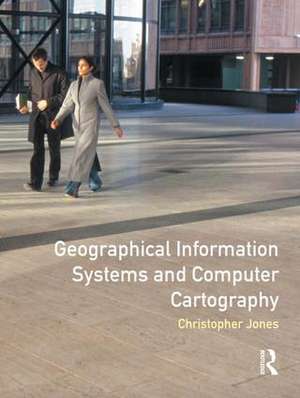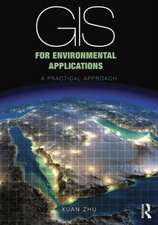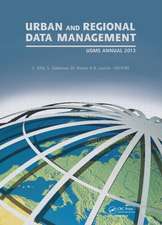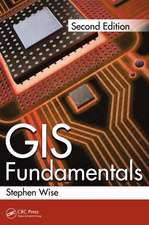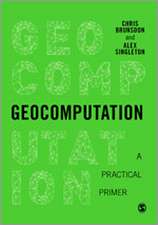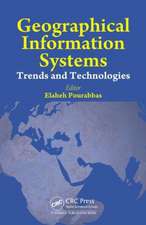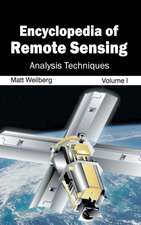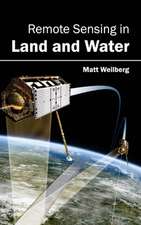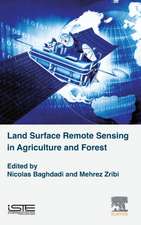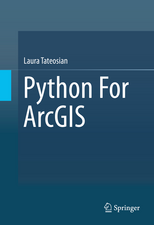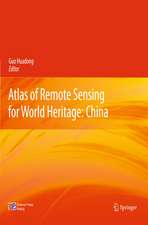Geographical Information Systems and Computer Cartography
Autor Chris B. Jonesen Limba Engleză Hardback – 24 dec 2014
Divided into five parts - the first part reviews the development and application of GIS, followed by a summary of the characteristics and representation of geographical information. It concludes with an overview of the functions provided by typical GIS systems. Part Two introduces co-ordinate systems and map projections, describes methods for digitising map data and gives an overview of remote sensing. Part Three deals with data storage and database management, as well as specialised techniques for accessing spatial data. Spatial modelling and analytical techniques for decision making form the subject of Part Four, while the final part is concerned with graphical representation, emphasising issues of graphics technology, cartographic design and map generalisation.
| Toate formatele și edițiile | Preț | Express |
|---|---|---|
| Paperback (1) | 585.27 lei 6-8 săpt. | |
| Taylor & Francis – 30 iul 1997 | 585.27 lei 6-8 săpt. | |
| Hardback (1) | 794.27 lei 6-8 săpt. | |
| Taylor & Francis – 24 dec 2014 | 794.27 lei 6-8 săpt. |
Preț: 794.27 lei
Preț vechi: 968.63 lei
-18% Nou
Puncte Express: 1191
Preț estimativ în valută:
151.98€ • 158.68$ • 125.79£
151.98€ • 158.68$ • 125.79£
Carte tipărită la comandă
Livrare economică 05-19 aprilie
Preluare comenzi: 021 569.72.76
Specificații
ISBN-13: 9781138835283
ISBN-10: 1138835285
Pagini: 344
Ilustrații: illustrations
Dimensiuni: 189 x 246 x 25 mm
Greutate: 0.79 kg
Ediția:1
Editura: Taylor & Francis
Colecția Routledge
Locul publicării:Oxford, United Kingdom
ISBN-10: 1138835285
Pagini: 344
Ilustrații: illustrations
Dimensiuni: 189 x 246 x 25 mm
Greutate: 0.79 kg
Ediția:1
Editura: Taylor & Francis
Colecția Routledge
Locul publicării:Oxford, United Kingdom
Cuprins
Part 1: Introduction.
1. Origins and Applications.
2. Geographical Information Concepts and Spatial Models.
3. GIS Functionality: An Overview.
Part 2: Acquisition of Geo-referenced Data.
4. Coordinate Systems, Transformations and Map Projections.
5. Digitising, Editing and Structuring.
6. Primary Data Acquisition from Ground and Remote Surveys.
7. Data Quality and Data Standards.
Part 3: Data Storage and Retrieval.
8. Computer Data Storage.
9. Database Management Systems.
10. Spatial Data Access Methods for Points, Lines and Polygons.
Part 4: Spatial Data Modelling and Analysis.
11. Surface Modelling and Spatial Interpolation.
12. Optimal Solutions and Spatial Search.
13. Knowledge-Based Systems and Automated Reasoning.
Part 5: Graphics, Images and Visualisation.
14. Computer Graphics Technology for Display and Interaction.
15. Three Dimensional Visualisation.
16. Raster and Vector Interconversions.
17. Map Generalisation.
18. Automated Design of Annotated Maps.
1. Origins and Applications.
2. Geographical Information Concepts and Spatial Models.
3. GIS Functionality: An Overview.
Part 2: Acquisition of Geo-referenced Data.
4. Coordinate Systems, Transformations and Map Projections.
5. Digitising, Editing and Structuring.
6. Primary Data Acquisition from Ground and Remote Surveys.
7. Data Quality and Data Standards.
Part 3: Data Storage and Retrieval.
8. Computer Data Storage.
9. Database Management Systems.
10. Spatial Data Access Methods for Points, Lines and Polygons.
Part 4: Spatial Data Modelling and Analysis.
11. Surface Modelling and Spatial Interpolation.
12. Optimal Solutions and Spatial Search.
13. Knowledge-Based Systems and Automated Reasoning.
Part 5: Graphics, Images and Visualisation.
14. Computer Graphics Technology for Display and Interaction.
15. Three Dimensional Visualisation.
16. Raster and Vector Interconversions.
17. Map Generalisation.
18. Automated Design of Annotated Maps.
Descriere
Provides a general introduction to the field which emphasises the basic concepts and technological foundations, gradually progressing from a basic introduction to the field to a more detailed treatment of particular aspects of the technology.
